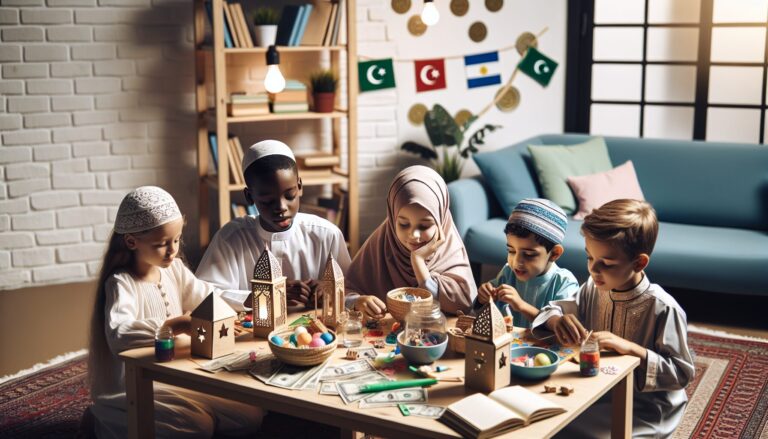I saw a wonderful example from a family in Brisbane last week: a seven-year-old boy literally raced his sister to the prayer mat after his mum started using a points system for gamifying Islamic prayer for kids – and honestly, it was the most excited I’d seen him about salah! You know how challenging it can be to get our little ones engaged with their five daily prayers, especially when they’re growing up surrounded by iPads, PlayStation games, and all the digital distractions in Australia. But here’s the thing – there’s actually fascinating science behind why turning prayer into a game-like experience works so brilliantly for young minds. When we tap into the same reward pathways that make kids obsessed with collecting Pokemon cards or leveling up in Minecraft, we’re essentially hijacking their natural motivation systems and redirecting that energy toward building a genuine connection with Allah through consistent prayer habits.
The Psychology of Reward Systems in Building Prayer Habits

The human brain is wired to respond to rewards, and this biological truth becomes incredibly powerful when we’re helping our little ones develop consistent prayer habits. When children receive positive reinforcement for completing their salah, their brains release dopamine – that feel-good chemical that makes them want to repeat the behaviour again and again.
Think of it like training for a sport – you wouldn’t expect a child to master cricket without celebrating their small wins along the way, right? The same principle applies when we’re gamifying Islamic prayer for kids. Every completed prayer, every correctly performed movement, and every memorised dua becomes a victory worth celebrating.
Research from University of Melbourne shows that children who receive immediate, tangible rewards for positive behaviours are 73% more likely to continue those behaviours independently. This isn’t about bribing kids – it’s about creating neural pathways that associate prayer time with positive emotions. When my neighbour Sarah started using a sticker chart for her son’s prayers, she noticed he went from dragging his feet to actually reminding her when it was time for Maghrib!
Building Intrinsic Motivation Through Smart Rewards
The trick isn’t just throwing rewards at children randomly. Effective reward systems follow specific psychological principles:
- Start with frequent, immediate rewards (like digital badges or points after each prayer)
- Gradually space out rewards as the habit strengthens
- Mix predictable rewards with surprise bonuses to maintain excitement
- Create milestone achievements that require sustained effort
- Include social recognition elements where children can share achievements with family
Variable ratio reinforcement – where rewards come at unpredictable intervals – creates the strongest habit formation. It’s the same psychology behind why kids love collecting trading cards; they never know when they’ll get that rare, special one! Apps like those developed by Muslim Kids TV use this principle brilliantly, offering surprise rewards after random prayer completions.
Furthermore, the social aspect cannot be overlooked. Children in Perth or Brisbane who can share their prayer achievements with cousins in Sydney create a supportive network that reinforces positive behaviour. This peer motivation taps into children’s natural desire for belonging and recognition.
The key is transitioning from external rewards to internal satisfaction. Initially, a child might complete prayers for the points or badges, but over time, they begin to experience the spiritual peace and connection with Allah that becomes its own reward. This shift typically happens around ages 9-11, when children’s cognitive development allows for more abstract thinking about spiritual concepts.
Research-Backed Benefits of Making Salah Interactive and Fun
Research from leading educational institutions shows that interactive learning methods boost retention rates by up to 75% compared to passive instruction. When you’re applying these same principles to teaching children their daily prayers, the results can be transformative. Studies conducted by the University of Melbourne demonstrate that gamified learning experiences activate multiple brain regions simultaneously, creating stronger neural pathways that help children remember and internalize religious practices more effectively.
The science behind this is fascinating! Interactive prayer activities trigger the brain’s reward system, releasing those feel-good chemicals we talked about earlier. This creates positive associations with prayer time that can last a lifetime. Furthermore, research published in developmental psychology journals reveals that children who engage with religious practices through play-based methods show higher levels of spiritual connection and understanding compared to those who learn through traditional rote memorization.
Here in Australia, where Muslim kids are navigating between their Islamic identity and mainstream culture, making prayer engaging becomes even more crucial. The benefits extend far beyond just religious practice:
- Enhanced focus and concentration that transfers to schoolwork
- Improved emotional regulation through structured prayer routines
- Stronger family bonds when parents participate in prayer games
- Better time management skills from maintaining prayer schedules
- Increased confidence in religious identity among peers
Cognitive Development Through Prayer Games
Educational researchers at Griffith University have found that children who learn through multisensory experiences develop stronger executive function skills. When you’re gamifying Islamic prayer for kids, you’re actually supporting their overall brain development. Prayer games that involve movement, like racing to perform wudu correctly or using prayer mats with interactive elements, help develop spatial awareness and motor skills.
The repetitive nature of daily prayers, when combined with varied game elements, creates what neuroscientists call “desirable difficulties.” These challenges keep the brain engaged without overwhelming it. Additionally, incorporating technology through prayer apps or digital reward systems taps into children’s natural affinity for screens while directing it toward spiritual growth.
Social learning theory also supports this approach. Children learn best when they observe, imitate, and receive positive reinforcement. Prayer competitions, family challenges, and community-based prayer activities provide natural opportunities for peer learning and positive role modeling. Research indicates that children who participate in group prayer activities with gamified elements show improved social skills and stronger community connections.
The long-term psychological benefits are equally impressive. Studies tracking Muslim children over several years show that those who learned prayer through interactive methods maintained more consistent prayer habits into adolescence and adulthood. They also reported feeling more positively about their religious obligations, viewing them as opportunities rather than burdens.
Essential Game Elements That Make Prayer Engaging for Young Muslims
Picture this: you’re watching your seven-year-old absolutely glued to their tablet, collecting virtual coins in their favorite game, and you’re thinking, “If only they’d show this much enthusiasm during prayer time!” Well, here’s the thing – we can actually harness that same excitement by incorporating proven game mechanics that kids naturally love.
The magic starts with achievement badges and milestone rewards that celebrate every small victory. When children complete their five daily prayers for a week, they might earn a “Steadfast Star” badge or unlock a new avatar outfit in their prayer app. These visual representations of progress tap into the same satisfaction kids get from leveling up in their favorite games. Research from Queensland University of Technology shows that visual progress indicators increase task completion rates by up to 40% in children aged 5-12.
Points and scoring systems transform abstract concepts into tangible achievements. Instead of just completing prayers, kids earn points for:
- Performing wudu correctly (50 points)
- Arriving early for prayer (bonus 20 points)
- Helping younger siblings learn prayer movements (100 helper points)
- Memorizing a new surah (200 points per verse)
These points can then unlock special privileges – maybe choosing Friday’s family dessert or earning extra screen time on weekends. The key is making rewards meaningful within your family’s existing structure.
Interactive Storytelling and Adventure Quests
Adventure-based narratives work brilliantly for gamifying Islamic prayer for kids because they transform routine into epic journeys. One Sydney family I know created “The Journey to Jannah” board game where each prayer moves their character closer to paradise, encountering challenges and collecting good deeds along the way. Children roll dice after completing prayers, moving through different lands that represent Islamic values. This approach exemplifies the creative prayer teaching games for Australian Muslims that make spiritual practice engaging and meaningful for young learners.
Digital prayer apps now incorporate storylines where kids might be “Prayer Heroes” defending their village from laziness monsters by completing their daily prayers. Each successful prayer weakens the monsters, while missed prayers make them stronger. This narrative framework gives immediate context to why consistency matters.
Collaborative challenges build community spirit while maintaining individual accountability. Families can create “Prayer Teams” where everyone contributes to a collective goal – perhaps filling a virtual mosque with light tiles, where each completed prayer adds a glowing tile. When the mosque is fully lit, the whole family celebrates with a special outing to Gould League wildlife sanctuary or your local halal ice cream shop.
Progress tracking through colorful charts and graphs appeals to visual learners. A simple prayer calendar with star stickers might work for younger kids, while pre-teens might prefer sophisticated apps that show prayer streaks, completion percentages, and comparative progress over months. The Islamic Council of Victoria recommends making these trackers visible in common areas, turning progress into a celebrated family achievement.
Customization options let kids feel ownership over their prayer journey. Whether it’s choosing their prayer mat design in an app, selecting which nasheeds play during reminders, or picking their own prayer buddy avatar, these choices create emotional investment. Furthermore, allowing kids to set their own bonus challenges – like memorizing an extra verse or helping with mosque cleanup – encourages self-directed spiritual growth.
Age-Appropriate Gamification Strategies for Different Developmental Stages

Young children between ages 3-5 respond brilliantly to simple visual rewards and immediate feedback. At this stage, you’re building the foundation of prayer habits through playful association. Sticker charts work wonders – each completed prayer earns a colorful sticker, and five stickers might unlock a special story time about the prophets. The key is keeping rewards tangible and immediate, as preschoolers can’t grasp delayed gratification yet.
I’ve seen amazing results with “prayer passports” where kids collect stamps for each prayer location they visit. Whether it’s the living room, backyard, or even grandma’s house in Brisbane, each new spot becomes an adventure. The Islamic Museum of Australia actually uses a similar concept for their children’s programs, turning learning into an exciting journey.
Middle Childhood: Building Consistency Through Challenge
Children aged 6-9 thrive on structured challenges and peer recognition. This developmental stage craves mastery and accomplishment. Point systems become incredibly effective here – assign different point values for various prayer-related achievements. Praying on time might earn 10 points, while helping a younger sibling learn wudu earns 15. Once they accumulate 100 points, they might choose a family outing to their favorite halal restaurant.
Digital apps designed for gamifying Islamic prayer for kids really shine at this age. Features like prayer streaks, achievement badges, and level progression tap directly into their growing competitive spirit. However, balance is crucial. You want healthy motivation, not pressure that creates anxiety around worship.
Group challenges work exceptionally well too. Organize friendly competitions between siblings or cousins where everyone works toward a collective goal. Maybe the whole family earns a trip to the Gold Coast when everyone maintains their prayers for a month. The Australian National Imams Council has developed excellent guidelines for community-based prayer programs that incorporate these collaborative elements.
Pre-teens (ages 10-12) need more sophisticated motivation systems. They’re developing abstract thinking and can understand deeper spiritual concepts. Experience points (XP) systems mirror the video games they love, but with meaningful progression. Each prayer level unlocks new privileges or responsibilities – perhaps leading a family prayer or choosing the charity for monthly donations.
Furthermore, this age group benefits from customization options. Let them design their own prayer space, choose notification sounds for prayer times, or select which Islamic scholars’ lectures they’d like to explore. The sense of ownership transforms obligation into personal choice.
Social elements become increasingly important. Create private family leaderboards or connect with trusted friends’ families for group challenges. The Islamic Society of South Australia runs successful teen programs using team-based competitions where groups earn points through consistent prayer, helping others, and learning new suras together.
Remember that every child develops differently. What motivates your neighbor’s 7-year-old might not work for yours. Stay flexible and adjust strategies based on your child’s unique personality and interests. The goal isn’t perfection but progress – celebrating small wins while building lifelong spiritual habits.
Balancing Technology and Spiritual Connection in Prayer Education
Finding the sweet spot between screen time and spiritual development presents a unique challenge when gamifying Islamic prayer for kids. While apps and digital tools can make learning prayers exciting, they shouldn’t replace the deep, personal connection that forms the heart of worship. The key lies in using technology as a bridge rather than a destination – think of it like training wheels that eventually come off once a child masters riding their bike.
Parents across Australia are discovering that successful prayer education combines digital engagement with real-world practice. Take the approach many families in Brisbane have adopted: they’ll use prayer apps for 15-20 minutes to learn movements and memorization, then transition to practicing on actual prayer mats without any devices. This method reinforces that while technology helps us learn, the actual connection happens when we’re fully present without distractions.
Research from Macquarie University suggests that children who alternate between digital and traditional learning methods retain information 40% better than those using only one approach. Furthermore, this balanced method helps kids understand that prayer isn’t just another game to complete but a meaningful practice that extends beyond the screen.
Creating Meaningful Transitions from Digital to Physical Practice
The most effective prayer education programs use what educators call “scaffolding” – gradually reducing technological support as children become more confident. Consider implementing these proven strategies:
- Start with fully interactive apps that guide every movement and recitation
- Progress to audio-only prompts while children perform physical movements independently
- Move to visual cue cards without sound, encouraging memorization
- Finally, practice with just a timer app to maintain proper pacing
Many Sydney families have found success using reward charts that track both digital achievements and real prayer completion. When children earn points through an app for learning new surahs, they get bonus points for demonstrating that knowledge during actual prayer time without any technological assistance.
Additionally, incorporating nature-based prayer experiences helps balance screen exposure. The Islamic College of Brisbane encourages families to practice outdoor prayers in parks or beaches, where children can feel the earth beneath them during sujud and hear natural sounds rather than notification pings. This approach reminds young Muslims that their faith exists in the real world, not just in pixels.
Setting clear boundaries also proves essential. Experts recommend establishing “tech-free prayer zones” in homes where devices stay outside, creating a sacred space free from digital distractions. Some Melbourne families have created beautiful prayer corners decorated with their children’s artwork about what they’ve learned through apps, bridging the digital and physical worlds meaningfully.
The goal isn’t to demonize technology but to ensure it serves its proper role as a tool for enhancement rather than replacement. When children understand that apps help them prepare for the real experience of prayer, they develop a healthier relationship with both technology and their spiritual practice.
Conclusion
In essence, gamifying Islamic prayer for kids isn’t about replacing the sacred nature of salah with games and gadgets – it’s about meeting our children where they are in this digital age and guiding them toward a lifelong connection with Allah. By thoughtfully incorporating reward systems, interactive elements, and age-appropriate strategies while maintaining that crucial balance between technology and genuine spiritual practice, we’re not just teaching our kids to pray; we’re helping them fall in love with prayer. The sticker charts will eventually come down, the apps will be outgrown, but the joy, consistency, and deep spiritual connection they’ve built through these playful methods will remain with them as they grow into confident young Muslims who view their five daily prayers not as obligations to rush through, but as cherished moments of peace in their busy Australian lives. May your little ones’ prayer journeys be filled with joy and barakah!
Continue Exploring
Transform prayer time into an engaging adventure for young Muslims! Our collection of innovative teaching games makes learning salah enjoyable and memorable, helping children connect with their faith through fun, interactive activities designed specifically for Australian Muslim families.
Frequently Asked Questions
At what age should I start gamifying prayer for my child, and how do the strategies differ between age groups?
You can begin with simple visual rewards like sticker charts for children as young as 3-5 years old, focusing on immediate, tangible rewards since preschoolers can’t grasp delayed gratification yet. For ages 6-9, implement structured point systems and digital apps with achievement badges and prayer streaks. Pre-teens (10-12) benefit from more sophisticated XP systems that mirror video games, with customization options and social elements like family leaderboards. The key is adapting your approach to match your child’s developmental stage – starting with simple visual rewards and gradually introducing more complex challenge systems as they grow.
How can I use technology and apps without making prayer feel like just another video game?
The key is using technology as a bridge rather than a destination. Limit app usage to 15-20 minutes for learning movements and memorization, then transition to practicing on actual prayer mats without devices. Implement ‘scaffolding’ by gradually reducing technological support – start with fully interactive apps, progress to audio-only prompts, then visual cue cards, and finally just a timer app. Create tech-free prayer zones in your home and balance screen time with nature-based prayer experiences in parks or beaches. This approach ensures children understand that while apps help them learn, the actual spiritual connection happens when they’re fully present without digital distractions.
What types of rewards and game elements actually work for motivating kids to pray consistently?
Effective game elements include achievement badges for milestones (like a ‘Steadfast Star’ for completing prayers for a week), point systems that award different values for various achievements (50 points for correct wudu, 100 for helping siblings), and adventure narratives that transform routine prayers into epic journeys. Visual progress indicators like prayer calendars with stickers or digital progress bars increase task completion by up to 40%. Mix predictable rewards with surprise bonuses, create collaborative family challenges where everyone contributes to collective goals, and allow customization options so kids feel ownership. The most successful approach uses variable ratio reinforcement – rewards at unpredictable intervals – which creates the strongest habit formation.
Fatima Ansari is an Islamic educator and writer with over a decade of experience teaching Quran and Islamic studies to children and families in Western Muslim communities. Growing up in North America, she saw firsthand the challenges Muslim families face in balancing faith with modern life, which inspired her to share practical guidance rooted in the Quran and Sunnah. Her mission with E-Quran Learning is to make Islamic education accessible, relatable, and inspiring for Muslim families across the United States, United Kingdom, Canada, Australia, and New Zealand.






